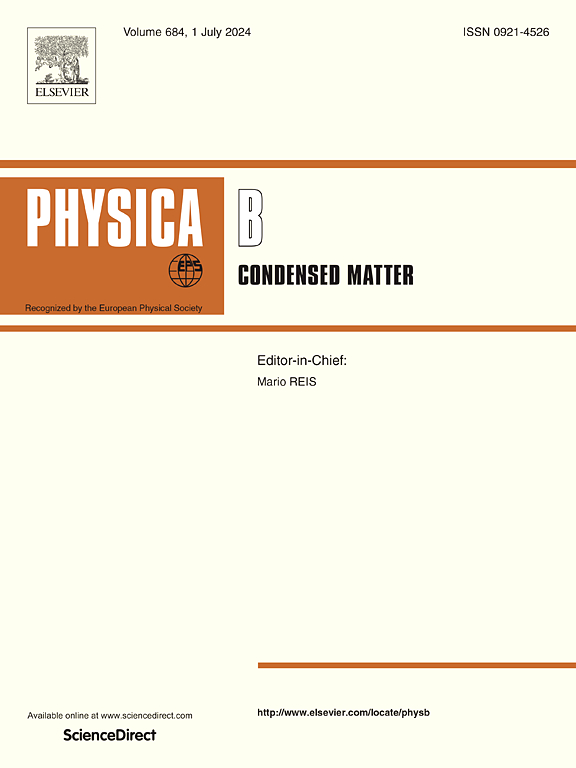双钙钛矿Cs2CuBiX6 (X=Br or I)的结构、电子、光学、弹性和热电性质的理论分析:DFT方法
IF 2.8
3区 物理与天体物理
Q2 PHYSICS, CONDENSED MATTER
引用次数: 0
摘要
由于双钙钛矿具有良好的光电和热电性能,在可再生能源领域的应用受到了广泛的关注。在本研究中,我们利用密度泛函理论(DFT)研究了Cs2CuBiX6 (X = Br, I)的结构、力学、光学和热电性质。化合物的形成能分别为- 2.11 eV/原子和- 2.08 eV/原子,证实了热力学稳定性。声子色散分析显示无虚模,表明动态稳定。利用GGA获得了基态性质,而利用trans - blaha修正的Becke-Johnson (tbj)势对电子和光学性质进行了改进,预测Cs2CuBiBr6和Cs2CuBiI6的间接带隙分别为0.903 eV和0.648 eV。光学分析显示出强极化,突出了这些材料在光伏应用中的潜力。力学性能评价揭示了其脆性行为。热电分析表明,Cs2CuBiI6表现出优异的性能,具有较高的塞贝克系数和导电性,使其成为更有前途的能量转换技术候选者。本文章由计算机程序翻译,如有差异,请以英文原文为准。
Theoretical analysis of structural, electronic, optical, elastic and thermoelectric properties of double perovskites Cs2CuBiX6 (X=Br or I): DFT approach
Double perovskites have attracted significant attention for renewable energy applications due to their promising optoelectronic and thermoelectric properties. In this study, we investigate the structural, mechanical, optical, and thermoelectric properties of Cs2CuBiX6 (X = Br, I) using density functional theory (DFT). The compounds exhibit negative formation energies of −2.11 eV/atom and −2.08 eV/atom, respectively, confirming thermodynamic stability. Phonon dispersion analysis reveals no imaginary modes, indicating dynamical stability. Ground-state properties are obtained using the GGA, while electronic and optical properties are refined using the Tran-Blaha modified Becke-Johnson (TB-mBJ) potential, predicting indirect bandgaps of 0.903 eV and 0.648 eV for Cs2CuBiBr6 and Cs2CuBiI6, respectively. Optical analyses indicate strong polarization, highlighting the potential of these materials in photovoltaic applications. Mechanical property evaluation reveals brittle behavior. Thermoelectric analysis shows that Cs2CuBiI6 demonstrates superior performance, with higher Seebeck coefficient and electrical conductivity, making it a more promising candidate for energy conversion technologies.
求助全文
通过发布文献求助,成功后即可免费获取论文全文。
去求助
来源期刊

Physica B-condensed Matter
物理-物理:凝聚态物理
CiteScore
4.90
自引率
7.10%
发文量
703
审稿时长
44 days
期刊介绍:
Physica B: Condensed Matter comprises all condensed matter and material physics that involve theoretical, computational and experimental work.
Papers should contain further developments and a proper discussion on the physics of experimental or theoretical results in one of the following areas:
-Magnetism
-Materials physics
-Nanostructures and nanomaterials
-Optics and optical materials
-Quantum materials
-Semiconductors
-Strongly correlated systems
-Superconductivity
-Surfaces and interfaces
 求助内容:
求助内容: 应助结果提醒方式:
应助结果提醒方式:


